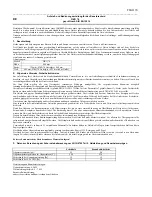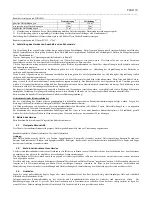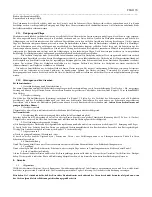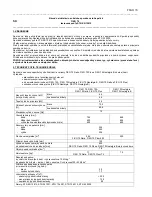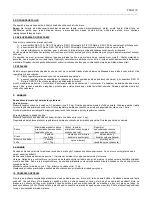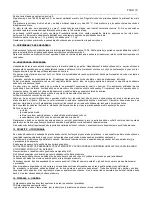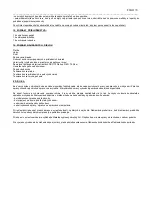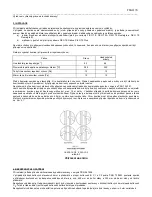
FIKO 70
_________________________________________________________________________________________
Burning lignite briquettes:
Nominal heating capacity can be obtained with 3 lignite briquettes (approx. 1.7 kg).
Use the rotary primary air slider on the ash box door to control the fire. Ash box door must be kept shut.
Fuel
Maximum quantity of fuel for
nominal heating capacity
Rotary primary air slider
(air flow through grille)
Secondary air slider (rotary or
sliding)
Wood
2 logs
(approx. 2.2 kg)
open at 10 mm (slightly open
for firing)
fully open (slider pushed in
completely)
Lignite briquettes
3 briquettes
(approx. 1.7 kg)
fully open
open at 3/4
(slider pulled out completely)
9. COOKING
Pots used for cooking should have a massive and flat bottom and a suitable lid. The cook-top lid must not be removed when cooking.
Firing flap valve must be set on position 1 (= open), oven door must be open.
Cooking: Wood is the most suitable fuel for cooking (temperature is maintained easier than with other fuels), cooking conditions are even better
when small quantities of fuel are added during cooking. When wood is not available put several doses of briquettes in the fireplace to make abundant
embers.
Fuel quantity: hard wood: approx. 1.1 kg, lignite briquettes: 1.1 kg.
Setting of primary and secondary air sliders is the same like for nominal heating capacity.
10. ROASTING AND BAKING
Do not put aluminium paper, pots and pans on the bottom of the oven to prevent enamel from deteriorating due to heat accumulation. Fruit juice
dropping from pans may leave irremovable spots on the enamel. The oven must be pre-heated. Pans with meals that need more space in height
should be put on a grille on the bottom of the oven or slid in one of the lower tracks. Pans with flat meals should be slid in the bottom track. Do not
use pans made of tinned (white) metal if possible.
Set the firing flap valve on 0.
Light fire should be kept to maintain a temperature of 180-200 ºC. Adjust the air sliders and add small quantities of fuel.
For roasting and grilling greater fire is needed to maintain a temperature over 250ºC. Exceptionally, long burning wood is the most suitable fuel for
roasting and grilling.
The same instructions like those for cooking apply here except the firing flap valve which must remain shut (position 0). If needed temperature is
impossible to be achieved with open slider then chimney draught is insufficient.
Flue way in the cooker needs to be cleaned. Also, make sure that all equipment connected to the same chimney is closed. If high temperature is still
difficult to be obtained, ask your chimney-sweep.
Fuel quantity: hard wood: 1.1 kg, lignite briquettes: 1.1 kg.
Setting of primary and secondary air sliders is the same like for nominal heating capacity.
11. OPERATING NOTES
The minimum operating chimney draught for trouble free operation is 12 Pa. The cooker should be cleaned thoroughly and checked as needed and
vermiculite replaced if deteriorated.
Service life of the cooker is longer with appropriate maintenance. Any cracking of the cooker when firing and cooling is not a defect.
12. ECONOMICAL OPERATION
Economical heating does not mean less heat but less fuel cost. Economical and effective operation is at risk if the cooker is untight, e.g. untight
draught shaft. Incorrectly installed smoke pipes may also show untightness. Therefore connection of the cooker directly to the chimney is the best
solution.
The cross section of the chimney for the cooker is 15x15 cm. Store fuel on a dry place. Dry fuel burns better and gives more heat with low
consumption.
Only acceptable fuels may be burn in the cooker. Follow the instructions in this manual for burning different fuels.
Do not add more fuel on the grille unless the first dose of fuel has not burnt well, otherwise you increase fuel consumption and vents are increasingly
loaded with soot.
Observe flue gas in the chimney outlet to see whether they are well burnt. Dark, thick flue gas appears when fuel is charged incorrectly and light flue
gas appears in a few minutes when fuel is charged correctly. No roaring sound can be heard in the cooker when heating is correct. Roaring indicates
incorrect heating, heat leakage and presence of unburnt substances in the chimney.
If roaring appears (when heating in line with these instructions) in the cooker, adjust the chimney draught by reducing the supply of air in the
fireplace.
After some time of heating fire may weaken in the cooker (usually in rooms with tight doors and windows) but it burns well when windows or doors
are open. Too tight room or lack of oxygen may be the reason. The problem can be solved by opening a window or a door. The best way how to
assure continuous intake of air in the room is to remove the sealing from the upper part of the window.
If the fire burns well after firing but degrades later, the grill may be charged with ash.
Bad burning is caused by:
- wet fuel,
- too thick fuel charge,
- poor fuel charge not covering the grille allowing cold air to flow around the charge,
- poor air supply into the fireplace or room.
Unless operated correctly the cooker may get loaded with soot and fine ash, therefore inside parts need to be cleaned from time to time in line with
the instructions herein. Soot in the flue ways and under the cook-top is undesired heat insulation.
Optimum air humidity is needed to obtain good conditions in the room therefore it is recommended to use evaporators.





